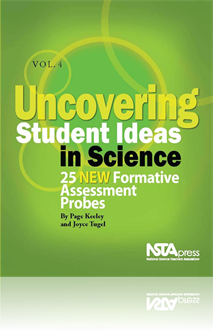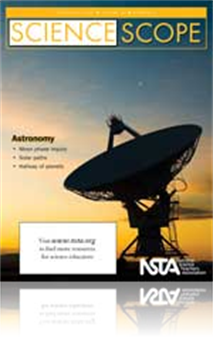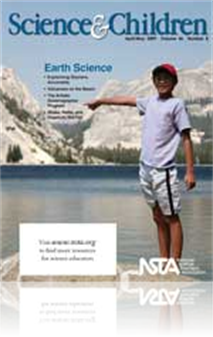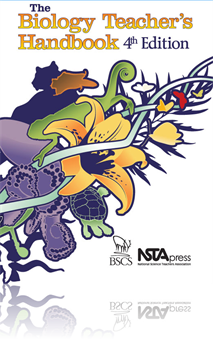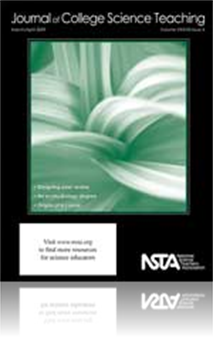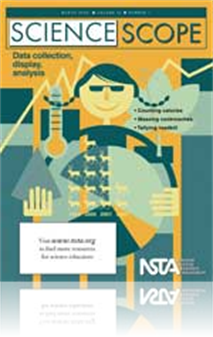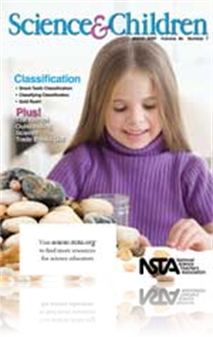All Resources
Book Chapter
The purpose of this assessment probe is to elicit students' ideas about the effect of solar radiation on Earth's temperature. The probe is designed to find out whether students realize the Earth continues to cool after sundown and up to sunrise until...
Book Chapter
The purpose of this assessment probe is to elicit students' ideas about conservation of matter during combustion. The probe is designed to find out if students think the mass changes as paper burns inside a closed system....
Book Chapter
The purpose of this assessment probe is to elicit students' ideas about temperature in the context of phases of matter. The probe is designed to find out if students recognize that the temperature of a substance does not change when two phases are pr...
Journal Article
Science Sampler: Happy science Mother’s Day
It’s almost May and review for final exams will soon be in full swing. Mother’s Day is celebrated every second Sunday in May. Have students combine their use of science vocabulary and their love for Mom by creating scientific Mother’s Day greet...
Journal Article
The State High Biodiesel Project
Through a collaborative project in Pennsylvania, high school students developed a method for converting batches of their cafeteria’s waste fryer oil into biodiesel using a 190 L (50 gal) reactor. While the biodiesel is used to supplement the school...
Journal Article
Explaining Glaciers, Accurately
What happens when a geology graduate student and two fourth-grade teachers collaborate on lessons for the classroom? They discover interesting and practical ways to explore geology and other scientific concepts, that's what! Here they share the glaci...
Journal Article
Career of the Month: An Interview With Ice Scientist Julienne Stroeve
While most of us may never see or feel Arctic sea ice ourselves, it directly influences the climate, wildlife, and people who live in the Arctic—and because of the link to global warming, the fate of sea ice affects the rest of us, too. As an ice s...
Journal Article
For many years, publications such as the National Science Education Standards (NRC 1996) and The Science Teacher (TST) have encouraged teachers to focus science classes more heavily on inquiry-based instructional practice. One way to improve our teac...
Journal Article
Shake, Rattle, and Hopefully Not Fall
Earthquakes occur across the globe, and their efforts can be felt by people regardless of location. However, a moderate earthquake in Pakistan or Turkey may cause much greater damage than a stronger earthquake in Tokyo. It is imperative to help stude...
Journal Article
Editor’s Corner: Outside the School Walls
This issue of The Science Teacher (TST) continues our tradition of devoting one issue each year to partnerships that connect students, teachers, and their communities. Science activities that take students outside school walls can combine the best as...
Journal Article
Like breathing, the ability to hear sound is often taken for granted unless it becomes impaired. Children may not wonder about how sound is generated or detected until introduced to an inquiry activity about sound. Therefore, to heighten students’ ...
Journal Article
Guest Editorial: The universe: It’s yours to discover—and to share
In 1609, Galileo turned his telescope to the sky and began a series of observations that would forever change our view of our place in the universe. This year, each and every one of us has an opportunity to follow in Galileo’s footsteps by taking a...
Journal Article
Idea Bank: Vector, Vector—That’s Our Cry!
There are all kinds of computer-based software programs and websites available to help students understand and manipulate vector quantities. But if you have the time and want to do something different, this Idea Bank describes an easy, low-tech, and ...
Journal Article
Safer Science: Biosafety—Getting the Bugs Out
Basic knowledge and adoption of biosafety guidelines, including disinfection and sterilization techniques, are a necessary component in high school biology laboratories. This is especially important if students or instructors are working with growing...
Journal Article
Integration With Big Ideas in Mind
Integrating science lessons with lessons in other content areas can be an efficient use of limited time, but not every activity can be integrated productively. Teachers must consider several factors when making decisions about which lessons to integr...
Journal Article
Teaching Through Trade Books: Sunrise, Sunset
The next time you watch the Sun rise; take a minute to think about what’s really going on. You are standing on a giant ball of rock that is hurtling through space, and the spot where you are standing is rotating in the direction of a star 93 millio...
Journal Article
Science Sampler: Space moves—Adding movement to solar system lessons
Earth and space science figure prominently in the National Science Education Standards for levels 5–8 (NRC 1996). The Earth in the Solar System standard focuses on students’ ability to understand (1) the composition of the solar system (Earth, Mo...
Journal Article
The Prepared Practitioner: An Assessment Primer
Although the title of this month’s column may make your skin crawl—read on. Everyone should understand a few basics about the “A” word. Being able to distinguish formative from summative assessment and criterion-based from norm-referenced tes...
Journal Article
Collaboration at the Nanoscale
The Maine ScienceCorps is a project sponsored by the National Science Foundation’s (NSF) Graduate Teaching Fellows in K–12 Education (GK–12 ) program. Through this program, the University of Southern Maine’s (USM) virology and transmission el...
Journal Article
Methods and Strategies: Keeping It Real
When teaching science, teachers must ensure that students have meaningful experiences outdoors where they use all their senses to better understand their local and easily observed environment and don’t fall into the habit of relying on computers an...
Journal Article
Perspectives: Societal Issues in Science
When students investigate local issues in science class, they gain research and critical-thinking skills while improving their attitudes toward science. However, since many societal issues are controversial, it is important to create a safe and risk-...
Journal Article
Editor’s Note: Scientists at Work in Earth Science
Working with outside resources almost always strengthens our classrooms. Whether it is taking a trip to a university lab or inviting scientists in, excitement builds as students experience the world of scientists. Whether partnering with scientists o...
Journal Article
Water You Engineering? An Activity to Develop Water-Quality Awareness
Water is one of our most precious resources. However, for many in the United States, having fresh, safe drinking water is taken for granted, and due to this perceived lack of relevance, students may not fully appreciate the luxury of having safe runn...
Journal Article
Science 101: Why are oceans salty and lakes and rivers not?
For starters, lakes and rivers do contain salt, just not as much as the oceans. A large portion of those salts and minerals washes downstream into other rivers, or through the outlet stream or river of a lake, and eventually winds up in the oceans. S...
Journal Article
Science Shorts: Word Wall Work—Supporting Science Talk
One goal of classroom teachers is for students to develop the ability to recognize and understand the vocabulary of science. Classroom teachers also understand that students “need to keep expanding their understanding of scientific terminology so t...
Book Chapter
If students develop an understanding of how science inquiry is done and how it contributes to understanding the natural world, they will be better prepared to analyze and interpret information throughout their lives. Merely telling students how knowl...
NSTA Press Book
40 Inquiry Exercises for the College Biology Lab
Drawing from the author’s own work as a lab developer, coordinator, and instructor, this one-of-a-kind text for college biology teachers uses the inquiry method in presenting 40 different lab exercises that make complicated biology subjects accessi...
By A. Daniel Johnson
Journal Article
Research and Teaching: Are In-Class Peer Leaders Effective in the Peer-Led Team-Learning Approach?
Peer-led team learning (PLTL) has been widely adopted for enhanced learning in a variety of disciplines, mostly in introductory chemistry, but also in organic chemistry, as in this study (Tien, Roth, and Kampmeier 2002). This pedagogical approach for...
Journal Article
Developing and Implementing an Interdisciplinary Origins Course at a State University
A truly interdisciplinary course was successfully developed and taught that presented an overview of the historical sciences with an emphasis on the nature of scientific inquiry and its relationship to other ways of knowing. The course included contr...
Journal Article
Secondary science teachers are faced with an increasing number of students whose first language is not English and charged with preparing them for federal- and state-mandated end-of-course exams. In many states, these high-stakes tests play a crucial...
Journal Article
Scope on the Skies: Star light, star bright
In astronomy, the brightness of a star is described in terms of a star’s magnitude. Stellar magnitude is expressed two different ways, using the terms apparent magnitude and absolute magnitude. For both magnitudes, the numbering scale is the same, ...
Journal Article
Classification and the Dichotomous Key
Classification is a vital science-process skill for all students to master. Understanding dichotomous keys as a means of classification enables students to better comprehend large amounts of information and understand how to organize, compare and con...
Journal Article
Science Shorts: About Form and Function
Humans have been classifying organisms since before recorded history, cataloging flora and fauna for our own species’ benefit. Recognition of particular forms—the bark of a tree, shape of a leaf, or color of a mushroom cap—could reveal importan...
Journal Article
Every Day Science Calendar: March 2009
This monthly feature contains facts and challenges for the science explorer....
Journal Article
The Prepared Practitioner: Multiple-Choice Season
Spring is almost here. Soon buds will appear on trees, and bubbled-in answers will appear on test response sheets all across America. Spring brings a spate of multiple-choice tests for many students—from SATs to AP exams to final exams to state and...
Journal Article
Idea Bank: Astronomy for Students With Sensory Impairments
The Space Exploration and Experience (SEE) Project and Yerkes Astrophysics Academy for Young Scientists (YAAYS)—both at the University of Chicago’s Yerkes Observatory in Williams Bay, Wisconsin—are designed to promote active learning in astrono...
Journal Article
Teaching With Multiple Methods in Mind
Teachers know what a daunting job it can be to ensure that all students in a class learn effectively. In addition to the usual difficulties of gaining everyone’s attention at once, instructors also run into the issue of preferred learning styles. I...
Journal Article
My students are on their cell phones all the time! Do cell phones really harm the brain? And what about the teen brain? ...
Journal Article
Scope on Safety: Safety in the Science Classroom—An online resource from NSTA
NSTA’s Science Safety Advisory Board has developed a new online resource for science teachers, Safety in the Science Classroom. The document introduces the Standards of Student Conduct in the laboratory and in the Field (SSCLF)—a list of behavior...
Journal Article
Your students successfully completed a lab session, correctly filled in all of the worksheets, and collected the required data. Yet, as a science teacher, you still find yourself wondering—what did my students actually learn? And, can they apply t...



